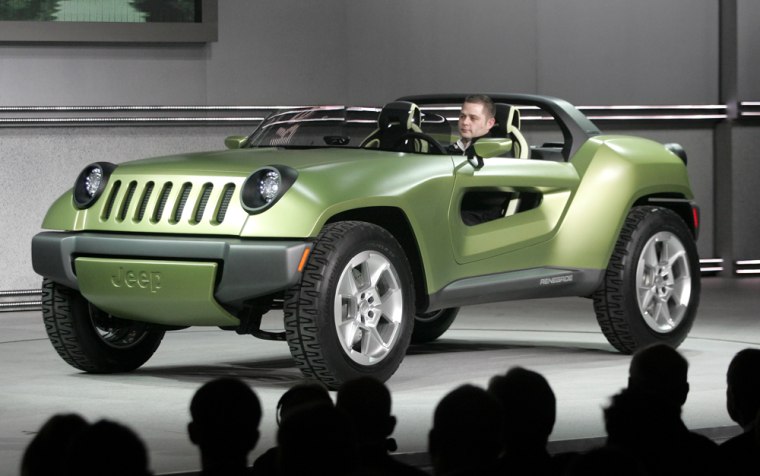Think of an “off-road” vehicle, and billy goat four-by-fours usually come to mind — the ones that chug along using muscular John Deere-style powerplants or diesel engines.
Electric motors? They’re for golf carts, or sissified urban commuter boxes and not for brawny rock crawlers, right?
The leading off-road manufacturers beg to differ. Judging by the concept cars shown by Jeep and Land Rover at this year’s Detroit auto show, they think electric motors do have a future in their vehicles.
The Army agrees on the potential of electrically driven vehicles and has a contract with Quantum Fuel Systems Technologies Worldwide to develop a diesel-electric Alternative Mobility Vehicle, or “Aggressor.”
Like civilians, the Army wants to cut fuel use, because fuel constitutes 70 percent of the materiel it moves into combat zones, according to Andy Abele, Quantum’s executive director of strategic development. Hybrid electric vehicles not only give soldiers the ability to sneak around quietly, they also serve as generators to power the myriad computer, radar, GPS, radio and other electronic systems upon which the modern military depends, he added.
Civilian interest in hybrid electric off-roaders comes from the “stylish green” segment of the market, according to Chrysler. (No, not “Soylent Green” — that was a Charlton Heston movie.) Stylish green refers to those extremely environmentally oriented consumers who appreciate high technology and innovation and also enjoy performance and style.
These consumers will embrace the stylish green concept and the ability to drive in near-silence, enjoying the peaceful wilderness, predicted Mark Williams, editor-in-chief of Truck Trend magazine.
“It is absolutely brilliant,” he said. “Jeep should exploit that for all it's worth. To connect with the quiet of nature is exactly the right way to go.”
Jeep’s Renegade concept, shown for the first time at this year’s Detroit show, examines the possibility of the company making the logical step into dune buggy-style vehicles — small, open vehicles with fat tires pushed to the far corners. The little Jeep features 268-horsepower electric motors on both the front and rear axles that allow four wheel-drive. These motors draw their power from a lithium-ion battery pack that provides a range of 40 miles.

The Renegade also has a 115 horsepower, 1.5-liter three-cylinder clean diesel engine for added power when needed, giving the vehicle a total range of 400 miles. The diesel-electric energy consumption is equivalent to 110 mpg, according to the company.
Lest traditionalists worry, yes, the Renegade still has the requisite hardware for putting the power to the ground in iffy conditions, with a low-range transfer case which lets off-roaders creep along at slow speeds and locking differentials which limit wheelspin.
Electric power is perfectly suited for off-roaders, according to Doug Quigly, executive engineer for Jeep’s environmentally responsible vehicles.
“It’s perfect for rock crawling, hill climbing and hill descent,” he said. In a normal internal combustion engine you have engine braking (which is when you slow down by lifting off the gas pedal), but “in an electric vehicle you do the same thing by putting power back in the battery the whole way down the hill.”
Today’s concept vehicles include internal combustion engine-powered generators because battery technology is insufficient to provide the needed range. But once off-roaders can be purely electric they will be much simpler and, in theory, more durable. Quigly notes that an electric vehicle has far fewer moving parts than one with an internal combustion engine, giving you “toughness and ease of maintenance.”
Also shown in Detroit, Land Rover’s LRX concept vehicle looks much more like today’s crop of compact sport utility vehicles but with a racy sloping roofline and a hybrid diesel-electric drivetrain meant to sip fuel. But that energy-saving mission doesn’t compromise the LRX’s Land Rover-grade off-road capabilities, the company promises.
In addition to a biodiesel-approved 2.0-liter clean diesel engine, the LRX includes an electric rear axle drive unit that lets the vehicle run on electric power alone at speeds below 20 mph. More importantly, it actually contributes improved capability.
“As our engineers looked at the challenge of using electric motors off-road, they considered their characteristics, such as peak torque at stall (zero revolutions per minute),” said Al Kammerer, Land Rover product development director.
That makes electric drive ideal for launching the LRX from a standstill on slippery surfaces, such as packed snow or wet grass, and also helps the vehicle get off the line when hitched to a trailer, he explained.
But off-road enthusiasts want to see for themselves.
“In theory, electric drive seems to make a lot of sense,” observed Truck Trend’s Williams. “But in practice, I haven’t seen or driven or felt anything that really gets me get over that technology hump.”
Land Rover is working to provide the necessary demonstration: “We have dedicated engineering who push the envelope on off-road technology,” Kammerer said. In conjunction with Cranfield University in England, Land Rover has developed the science of “terra mechanics” using an indoor sand pit to provide repeatable conditions for comparison tests, he said.
The LRX also has an integrated starter-generator of the sort used by conventional hybrids, which lets the diesel engine stop when idling at traffic lights and restart instantly in response to a touch of the gas pedal, helping to save fuel.
And the LRX features an expanded version of Land Rover’s Terrain Response system, which tailors the engine management, all-wheel-drive, traction control and other electronically controlled systems to the current conditions. In addition to the “general driving,” “sport,” “sand” and “grass/gravel/snow” settings, the LRX enjoys an additional “Eco” setting, which optimizes the vehicle for maximum on-road fuel economy.
The Army's “Aggressor” vehicle is also optimized for fuel economy, because the less fuel the military needs, the fewer transport convoys there are to be targeted by enemies.
Quantum initially proposed a super-efficient fuel cell vehicle, and it hopes that will be the ultimate solution. But for reasons of practicality the military needs all of its vehicles to use the same JP-8 fuel, which is similar to diesel fuel, kerosene and jet fuel.
So the vehicle now being developed uses a diesel engine to charge its batteries, just like the Jeep Renegade and Land Rover LRX concepts. And it can charge other batteries too.
“The military is moving to electronic gear,” observed Quantum’s Abele. “With a hybrid electric you have a generator set on wheels, so you can plug in your electronic gear.”
That potential appeals to consumers too.
“Personally, I love the idea of being able to drive a generator to my campsite,” Williams said.
